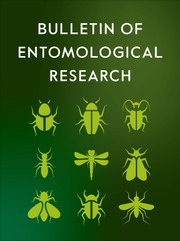No CrossRef data available.
Article contents
Molecular characterisation of the sHsps genes in Spodoptera frugiperda and analysis of their expression patterns to temperature and ultraviolet stress
Published online by Cambridge University Press: 27 August 2025
Abstract
Spodoptera frugiperda (Lepidoptera: Noctuidae), commonly known as the fall armyworm (FAW), is an invasive pest known for its rapid migration, strong adaptability, and wide host range. Small heat shock proteins (sHsps) are a specific class of Hsps associated with the molecular mechanisms of insect growth and development and the response to abiotic stresses, such as extreme temperatures, ultraviolet (UV) rays, and pesticides. Herein, six sHsps, SfsHsp11.2, SfsHsp15.8, SfsHsp20.2, SfsHsp21.4, SfsHsp22, and SfsHsp26.6, were successfully cloned and identified from FAW. The six SfsHsps all have an α-crystallin domain in their amino acid sequences. Furthermore, we investigated the expression patterns of these six SfsHsps in different tissues and developmental stages of FAW using real-time quantitative polymerase chain reaction. Their expression levels in adult FAW were also analysed under extreme temperatures (36°C and 4°C) and UV-A stress for different durations (0, 30, 60, 90, and 120 min). Our findings revealed distinct expression profiles for the six SfsHsps in different FAW tissues and developmental stages. Notably, under temperature and UV-A stress, most SfsHsp genes were significantly upregulated in adults. Our findings strongly indicate that SfsHsps are crucial in the development and stress response of S. frugiperda.
Information
- Type
- Research Paper
- Information
- Copyright
- © The Author(s), 2025. Published by Cambridge University Press.


